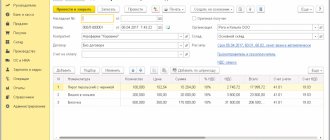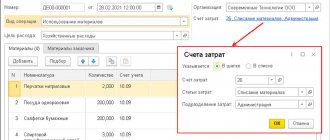The concept of revenue in accounting
Based on PBU 9/99 “Income of the organization”, revenue in accounting can be recognized only if: (click to expand)
- the enterprise has the right to receive this revenue, that is, this right must be confirmed either by a concluded agreement or in another way;
- the amount of revenue can be determined;
- after receiving the proceeds, the organization will receive economic benefits;
- the goods have been transferred to the buyer, or the service has been provided (work accepted);
- It is possible to determine the expenses that an organization incurred to obtain specific revenue.
Revenue recognition
Paragraph 12 of PBU 9/99 defines five conditions, upon the simultaneous fulfillment of which revenue is recognized in accounting:
- the organization has the right to receive revenue, which arises from a specific agreement or is confirmed in another appropriate manner;
- the amount of revenue can be determined;
- there is confidence that as a result of a particular transaction there will be an increase in the economic benefits of the organization (when the organization received an asset in payment or there is no uncertainty regarding the receipt of the asset);
- the right of ownership (possession, use and disposal) of the product (goods) has passed from the organization to the buyer or the work has been accepted by the customer (service provided);
- the expenses that have been or will be incurred in connection with this operation can be determined.
If at least one of the conditions listed above is not met in relation to the received cash and other assets, the organization’s accounting records recognize not revenue, but accounts payable.
To recognize revenue from the provision for a fee for temporary use (temporary possession and use) of company assets, rights arising from patents for inventions, industrial designs and other types of intellectual property and from participation in the authorized capital of other organizations, it is sufficient to simultaneously fulfill the first three conditions.
Revenue from the performance of work, provision of services or sale of products with a long production cycle is allowed to be recognized in accounting as they are ready in general. That is, in the contract between the contractor and the customer, it is advisable to provide for the condition of stage-by-stage delivery of work, services, and manufactured products. As for revenue from the performance of specific work, services, or the sale of a certain product, it is recognized upon readiness only if such readiness can be determined (clause 13 of PBU 9/99). Otherwise, revenue in the accounting records of the contractor will be recognized upon completion of the work, provision of services, and sale of finished products in general.
It is also allowed to simultaneously apply different methods of revenue recognition in one reporting period. But this is only possible in relation to work, provision of services, and manufacture of products that are different in nature and conditions.
Paragraph 14 of PBU 9/99 establishes that if the amount of revenue cannot be determined, then it is reflected in the amount of expenses recognized in accounting for the manufacture of products, performance of work or provision of services, which will subsequently be reimbursed to the organization.
Rent and license payments for the use of intellectual property objects (if this activity is not the main activity for the company) are recognized in accounting based on the assumption of temporary certainty of the facts of economic activity and the terms of the concluded agreement (clause 15 of PBU 9/99). Such income should be reflected in a manner similar to that provided for in paragraph 12 of PBU 9/99, which we have already mentioned.
Reflection of revenue in accounting
In order to reflect revenue in accounting, you need to rely on supporting documents. That is, on such documents that can confirm that the right to the goods has transferred to the buyer, for example, a deed or invoice, as well as other primary documents. There are a certain number of requirements for these primary documents. They, for example, must be drawn up either according to standard forms of accounting documentation, or according to a form approved by the organization.
The procedure for determining revenue, according to PBU 9/99, revenue is taken to be those amounts that are equal to receipts of money and property in monetary terms, as well as accounts receivable. At the same time, revenue is recognized in accounting taking into account VAT and excise duties, but they are not revenue.
In cases where the buyer does not fully pay his debt to the company, revenue should be recognized in the accounting of the supplier organization as the amount of payment received, as well as receivables from this buyer.
In case of sale of products
With this type of income generation, such as recognizing revenue from the sale of products, not everything is simple, since there is a method of determining “as ready” for products that has a long production cycle. To apply it, you need to be able to determine partial readiness or use the criteria for completing a stage of work (clause 13 of PBU 9/99). If we are talking about construction, then PBU 2/2008 “Accounting for construction contracts” is applied. Other products or works can be found in the list of Government Decree No. 468 dated July 28, 2006. But for them you need to obtain a special document from the Ministry of Industry and Trade according to the Order of the Ministry of Industry and Trade dated June 7, 2012 No. 750. Both the Decree and the Order are needed for correct accounting of VAT on goods and works long production cycle. But the definition and recognition of revenue from the sale of products in accounting and tax accounting can be carried out in the same way, since Regulation BU 9/99 does not provide any specifics on products and long-cycle work.
Methods of revenue recognition in accounting
There are two methods for recording revenue in accounting:
- Accrual method - is a generally accepted method, revenue is recorded as shipment;
- Cash method - revenue with this method is taken into account when payment is received.
The accrual method is used by all organizations to account for all revenue, with the exception of revenue under contracts with a special right to transfer ownership.
By the way, small businesses are given the right to choose; they can use both the accrual method and the cash method. This possibility is provided for in clause 20 of the Standard Accounting Recommendations. But when using the cash accrual method, the following requirement must be taken into account: expenses are recognized only after the debt is repaid.
The chosen method of revenue recognition is necessarily recorded in the accounting policies of the organization. The cash method is more convenient to use only for those small businesses that do not have many business transactions. Since, under the cash method, a company recognizes expenses only after they have been paid, then with a large number of such expenses, it is very difficult to track which of them are reflected in accounting and which are not yet.
When the cash method is used, costs that are related to the sale of products should be reflected in account 20 “Main production”.
Features that arise when determining revenue
- When the price is not determined. Sales of products, provision of services and other activities for which the company receives revenue occur on the basis of an agreement between the buyer and the customer. In this case, the contract, as a rule, provides for the establishment of a price. However, there are also contracts where the price is not provided and is determined based on the prices charged for similar types of goods. Revenue in this case is also determined by the price of similar goods.
- Transfer of ownership after receipt of funds. Revenue under this type of contract is determined on the date of receipt of money.
- When providing a commercial loan. When the buyer is granted a deferred payment, the proceeds are accepted in the full amount of the debt. The term of the so-called loan does not matter.
- When paying not in cash. The Civil Code of the Russian Federation allows the option of non-monetary payment only under an exchange agreement. Revenue under such contracts is taken into account at the cost of the goods that the organization receives. In this case, the cost of the goods is determined based on the cost of similar goods (works, services). When the cost of the goods received cannot be determined for some reason, the organization will determine revenue based on the cost of the goods transferred in exchange. The cost of your goods should be similar to the cost of usually shipped goods.
- When the obligation under the contract changes, when a discount is provided. There are situations when the price changes after the contract has been concluded. For example, it is possible to provide a discount. If the goods are transferred to the buyer already taking into account the discount, then there will be no need to adjust the revenue in this case. And if the discount is provided after the shipment has taken place and after the relevant documents have been issued, then the selling company will need to adjust the revenue by creating the posting: D62 K90-1 – REVERSE! Sales revenue is adjusted by the discount amount.
- When returning an item. If a situation arises when the buyer returns the goods, then an adjustment must be made in accounting for revenue, otherwise at the end of the period it will reflect an incorrect result. When the sale of goods and the return of goods occur in the same tax period, then it is necessary to adjust the 90 “Sales” account. But if the return occurs only next year, then the cost of this product will be reflected in non-operating expenses in the form of a loss from previous years and taken into account in account 91 “Other income and expenses.”
- When setting the price in USD There are also situations when settlement under an agreement occurs in rubles, but is equivalent to an amount in the currency of another country or in conventionally accepted units. In this case, the parties to the contract set the date for recalculating the price either from the foreign exchange rate at the time of payment or on the day of shipment. The peculiarity of such an agreement is that the final price is formed only after calculation. That is, the final cost of goods in Russian currency is determined at the time of final settlement and consists of partial payment for future deliveries, as well as other amounts transferred for the goods. The moment of determining revenue will be an earlier date, either the date of shipment or the moment of payment.
- When creating a reserve for doubtful debts. When creating a reserve for debts, the amount of revenue should not change.
Revenue recognition example
Continent LLC ships goods to the Counterparty on prepayment. On the date of transfer of the goods, ownership rights also pass. Revenue is accordingly recognized on the date of shipment. Let's reflect these transactions in accounting with the appropriate entries:
- D51 K62 – Prepayment received for future shipment
- D62 K68 – VAT accrued (as of the date the tax base was determined)
- D62 K90-1 – Products shipped
- D90-3 K68 – VAT charged
- D68 K62 – VAT calculated at the time of shipment is accepted for deduction
Cost calculation in 1C. Services and works
- revenue is reflected on the credit of account 90.01 by name of work;
- on the debit of account 90.02, from the credit of account 20, the cost of work (services) performed is written off.
Option No. 1. Without taking into account revenue from work (provision of services)
- All costs accounted for on account 20 for work and services will be written off automatically in full in Dt 90.02 always at the close of the month. Regardless of whether the proceeds from loan 90.01 are reflected or not reflected at all.
Option No. 2. Taking into account the proceeds from the performance of work (provision of services)
- If revenue is reflected for a product group, then the costs recorded on account 20 for the same product group will be written off automatically for the entire amount in Dt 90.02 when closing the month.
- If there was no revenue for the item group, then the costs will NOT be written off , but will remain as work in progress in the debit of account 20.
Option No. 3. Taking into account revenue only from production services
- Revenue from works and services should be reflected only using the document Provision of production services
. - If revenue is reflected by product group using this document, then the costs recorded on account 20 for the same product group will be written off automatically for the entire amount in Dt 90.02 when closing the month.
- If there was no revenue for the product group or it is reflected in the document Sales of goods and services
, then the costs will not be written off, but will remain in the form of work in progress in the debit of account 20.
Answers to common questions
Question No. 1. “To recognize revenue for the sale of goods, is a contract sufficient, or are some other documents required?”
In order to recognize revenue in accounting, one contract is not enough. Since we are dealing with the sale of goods, in addition to the contract, a TORG-12 invoice must be issued.
Question No. 2. “The date of recognition of revenue and the date of recognition of the tax base are the same?” (click to expand)
No, the tax base can be determined on the day of shipment, and revenue recognized on the day of payment. These dates may be the same or different. In any case, the moment of recognition of the tax base and the moment of recognition of revenue must be fixed in the company's accounting policies.
Revenue from sales of goods, works and services
Nomenclature group
- this is a type of industrial and technical equipment, i.e. it is a generalized concept that accumulates costs and revenues by type of product, goods, work and services
The link Nomenclature
groups
for sales of products and services determines the types of industrial and industrial goods of own production, the proceeds from the sale of which must be reflected in the income tax return on page 011 of Appendix No. 1 to Sheet 02 “Income from sales and non-operating income.”
To fill out other lines of Appendix No. 1 to Sheet 02, there is no need to make special settings in the accounting policy.
See also:
- Accounting policy designer
- Setting up accounting policies for NU (STS)
- Setting up accounting policies for NU in 1C: Income Tax
- Accounting policy in 1C 8.3 Accounting 3.0
- Accounting policy for accounting: Distribution of indirect costs
- Implementation of work
- Provision of services with write-off of direct costs
- Sales of products
Did the article help?
Get another secret bonus and full access to the BukhExpert8 help system for 14 days free of charge









